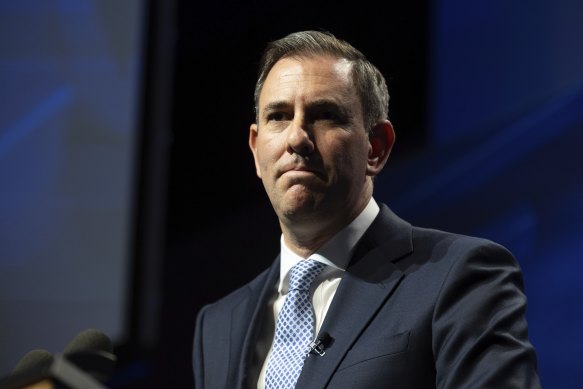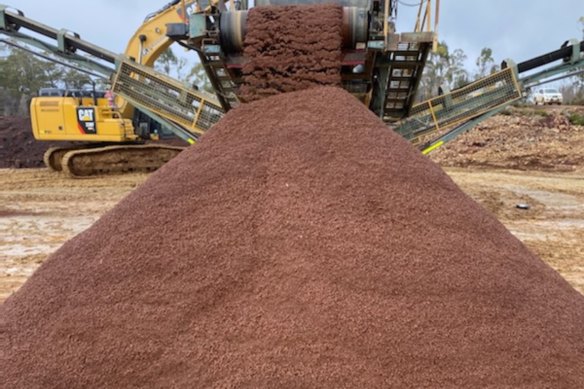Opinion
What Australia needs from China – more building, more babies
Elizabeth Knight
Business columnistTreasurer Jim Chalmers has finally acknowledged the Australian economy’s elephant in the room – and it’s China’s stalling economy.
While the US sharemarket dictates the trajectory of our equities market, the Chinese economy feeds our resource-heavy economy.

Treasurer Jim Chalmers has finally joined in sounding alarm bells on China’s stalling economy.Credit: Alex Ellinghausen
Sure, economist boffins have been on high alert about China’s construction rout undermining the price of our biggest export iron ore, but Canberra has finally joined in sounding alarm bells.
You would have to question the coincidence of Chalmers raising China’s deteriorating economy over the weekend after Reserve Bank governor Michele Bullock raised a red flag on China at a Senate estimates hearing on Friday.
Meanwhile, the A2 Milk company fed into the troublesome China story, revealing on Monday that the country’s infant milk formula market was down 10.7 per cent in value in the 2024 financial year, thanks in large part to a 6 per cent drop in China’s birth rate in 2023. Large as that seems, it follows a 10 per cent fall in 2022, a 12 per cent fall in 2021 and an 18 per cent drop the year before.
The slowing birth rate will continue to put pressure on Australian businesses that export to that sector of the market, but it’s the deflating property bubble in China focusing Treasury’s attention, as the rivers of gold flowing from the taxation of iron ore miners have a huge impact on the government’s coffers.
The price of the red metal has now fallen below where Treasury had expected it would land, and over the past week alone has plunged by 7.5 per cent.
Although Treasury had built a decline in the iron ore price into its forecasts, the trajectory of the fall is steeper than expected and could shave $3 billion from its tax receipts over four years.
It is also worth noting that Treasury traditionally employs very conservative estimates of the future iron ore prices.
The latest slump appears to be in response to a disturbing statement from China’s biggest steelmaker, Baowu, which eerily predicted the downturn in the steelmaking industry would be “longer, colder and more difficult to endure than we expected”.
It’s the deflating property bubble in China that is focusing Treasury’s attention, as the rivers of gold flowing from the taxation of iron ore miners have a huge impact on the government’s coffers.
Baowu chairman Hu Wangming, who made the comments at the company’s half-year meeting, said the challenge could be worse than the “major traumas” of 2008 and 2015. At the end of 2015, iron ore prices traded below $US40 a tonne.
The iron ore price has now fallen 38 per cent this calendar year and is sitting just north of $US97 a tonne.
The concern about the iron ore price has clearly fed into the share prices of our big producers. BHP shares have fallen more than 21 per cent this year, Rio Tinto’s stock has deteriorated by almost 20 per cent and Fortescue’s shares have lost 42 per cent of their value. Brazilian producer Vale is down 35 per cent.
That’s a cumulative wipeout of around $US100 billion ($150 billion).

Iron ore is vital to the Australian economy.
The miners saw some of the fall in iron ore prices over the past year reflected in their results for the year to June, but since then, the reduction in pricing has been steeper.
The miners historically have counted on the Chinese government to introduce large-scale stimulus packages to kick-start growth in China’s economy and its housing market, but such measures have been quite muted to date.
China posted weaker-than-expected growth in the June quarter of 2024, with real GDP rising by 0.7 per cent to be 4.7 per cent higher through the year. Home prices posted their sharpest fall on record to be 8.2 per cent lower through the year in July. In the 12 months to July, residential construction starts are down about 60 per cent on their peak in 2021.
Conventional wisdom says there is a floor to be found in the iron ore prices when the more marginal producers mothball operations as their costs outweigh the price.
But if demand continues to dry up rapidly, that floor may be lower than it has been in the past.
The Business Briefing newsletter delivers major stories, exclusive coverage and expert opinion. Sign up to get it every weekday morning.